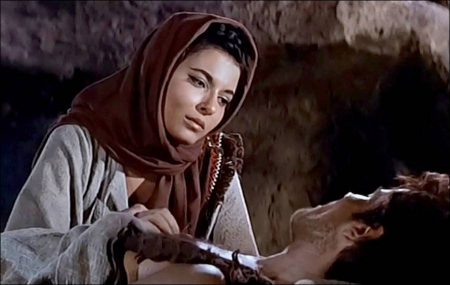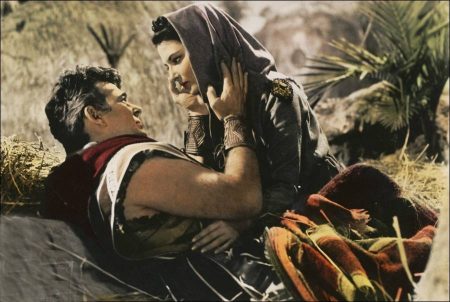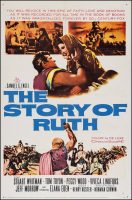The Story of Ruth movie storyline. Inspired by the tale from Hebrew scriptures and the Christian Bible, the Moabitess child Ruth is sold to the temple of Chemosh. Years pass and she serves as a priestess to the idol. While arranging a temple ritual, she encounters a Judean family of artisans: Elimelech, his wife Naomi, their sons Chilion and Mahlon, and daughter-in-law Orpah. Ruth is curious about their God, and begins to meet secretly with Mahlon. After tragedy strikes, Ruth follows Naomi and begins a new life in Bethlehem.
The Story of Ruth is a 1960 American historical romance film directed by Henry Koster, shot in CinemaScope and DeLuxe Color, and released by 20th Century Fox. The screenplay, written by Norman Corwin, is an adaptation of the biblical Book of Ruth. The film stars Stuart Whitman as Boaz, Tom Tryon as Mahlon, Peggy Wood as Naomi, Viveca Lindfors as Eleilat, Jeff Morrow as Tob, and introduces 19-year old Elana Eden as Ruth.
In 1957, Simon Windelburg was announced as the film’s screenwriter. Michael Kanin and his wife, Fay Kanin, who were later hired to write the screenplay, wrote treatments for the film. Frank G. Slaughter wrote a screenplay based on his 1954 novel The Song of Ruth: A Love Story From the Old Testament. Norman Corwin wrote an entirely new screenplay after summer 1958. Corwin submitted his final draft of the script on September 1, 1959. Production began in late November 1959 and ended in mid-February 1960.
Film Review for The Story of Ruth
Many scholars see Ruth as a relatively late addition to the Hebrew bible, brought in (along with Jonah) around the time of Ezra either to balance, or directly rebuke the rise of anti-gentile sentiment amongst the Israelites. Interestingly then, Henry Koster’s 1960 film The Story of Ruth could be argued to be fulfilling the same function in mid-twentieth century America.
In many ways Koster’s film is a rebuff to DeMile’s The Ten Commandments. There, DeMille pitched the Israelites as proto-Americans who God delivered from the dictator led Egyptians in a prefiguring of the cold war. Norman Corwin’s script frequently inserts references to the Israelite laws regarding care for aliens as if throwing out the challenge to an increasingly paranoid America. If the US wanted to see itself as the new Israel, then it had better start acting like it.
One of the by-products of McCarthyism was that many screen writers with leftist sympathies had to leave Hollywood and head for pastures new. Naomi’s return to Bethlehem also perhaps mirrors the return home of a number of writers as a decade of paranoia and suspicion subsided.
The other contribution The Story of Ruth has to make is it’s midrashic extrapolation of the biblical text. The book of Ruth is just four short chapters long, and some of the most pivotal figures are dead almost before the story has begun. Naomi and Ruth’s husbands, Elimelech and Mahlon, make unusual yet significant decisions Elimelech moves his family to a foreign land, and Mahlon takes a foreign wife.
The Story of Ruth takes its time over this pre-story, at least as far as Mahlon is concerned. Of all the figures in the film, he is the one who is the most readily identifiable with a biblical epic archetype. Whilst his character is far more fleshed out than in the scriptures, he is certainly far simpler than Boaz turns out to be. On the one hand, Mahlon is good, upright and moral, particular in contrast to the child sacrificing Moabites he lives amongst. But come the odd bit of injustice, he is perfectly willing to fight with a sword, and set fire to a vast set in order to make his escape.
The focus of these early scenes is Ruth, and her metamorphosis from a idol worshipping pagan to a God fearing one. Indoctrinated from childhood, it is only when she meets with someone from another faith that she questions her own. It turns out that she was good at heart all along. All of which raises two questions – why if such good people existed in non-Israelite tribes were those tribes so indiscriminately slaughtered on occasion. Secondly, if that situation was the case then, it surely must have something to say about those pockets of contemporary Christianity which see all members of other religions as destined for damnation.
Once Ruth’s transformation is complete, however, she gradually becomes less of the focus, and Naomi and Boaz move to centre stage. The two are not on good terms. Boaz is much changed from his youth, and torn between politics, the law and soon his love for Ruth. In contrast to the biblical accounts Boaz is brutish with Ruth when he first meets her and remains distant for some time. This is contrasted with the reaction of his kinsman, Tob, who’s first meeting with Ruth results in him forsaking opportunities to claim property, and being overly helpful to Ruth and her mother-in-law.
Portraying these two male leads in such a fashion allows the film to try and negotiate some of the strangest customs mentioned in the bible. The gleaning laws have been preserved in the text of Leviticus (23:22), but what exactly the story was with the exchange of the sandal and the subtleties of the inheritance laws are far less clear. Some of these are brought to prominence others sidelined. Indeed it could be argued that Tob refusing the wealth Boaz offers him demonstrates that his motives are the very opposite of his biblical counterpart.
In the end, however, Tob’s attitude to women is that which would have been standard in biblical times – they were seen as property. Whilst Tob’s last gasp change of heart is muddled and unconvincing, it does highlight that Boaz actually loves her. In fact, even in the bible that appears to be the case. The film dilutes this observation, however, by portraying the norm as marriage for love rather than possession / survival. It is fairly likely that the person Ruth would have loved the most would have been Naomi.
The film also touches on the role of both Naomi and Ruth in the ancestry of King David. It cleverly gets around the book’s inserting a narrator by inserting an angel / holy man / prophet into a couple of scenes. He not only predicts their role in David’s line, but also that of one “who some say will be the messiah”. The phrasing is sufficiently ambiguous to avoid offending either Christians or Jews. Biblical scholars, however, cannot fail to spot the anachronism of talking about a messiah long before anyone in Israel had any concept of what one might be.
The greatest weakness of The Story of Ruth, however, is that it is twenty minutes too long. There is much unnecessary material inserted into the story when really the film should be wrapping up. A sub-plot concerning two Moabite soldiers trying to track Ruth down, and their attempt to stir up trouble for her with the townsfolk is muddled, cheesy and banal. Whilst it serves to deepen Boaz’s complexity a little, overall it detracts from much of the good work elsewhere. Likewise Mahlon’s rescue scene seems to have been added largely to increase the entertainment factor, which studio exces may have been concerned about given the absence of orgy scenes and scantily clad women.
Without those two excesses the film would have been brave indeed. Without battle scenes and overly demonstrative love affairs typical of epic films of the period, the film is able to take a far more serious look at some of the real issues behind the story. An early miracle makes it clear that this is a film that recognises God in all that will go on, but that will be concentrating on the other issues that surround this unusual story.
The Story of Ruth (1960)
Directed by: Henry Koster
Starring: Elana Eden, Stuart Whitman, Tom Tryon, Peggy Wood, Viveca Lindfors, Jeff Morrow, Thayer David, Les Tremayne, Eduard Franz, Leo Fuchs, Lili Valenty, John Gabriel, Ziva Rodann
Screenplay by: Norman Corwin
Cinematography by: Arthur E. Arling
Film Editing by: Jack W. Holmes
Costume Design by: Vittorio Nino Novarese
Set Decoration by: Stuart A. Reiss, Walter M. Scott
Art Direction by: Franz Bachelin, Lyle R. Wheeler
Music by: Franz Waxman
MPAA Rating: None.
Distributed by: 20th Century Fox
Release Date: June 17, 1960 (New York City premiere)
Views: 639



